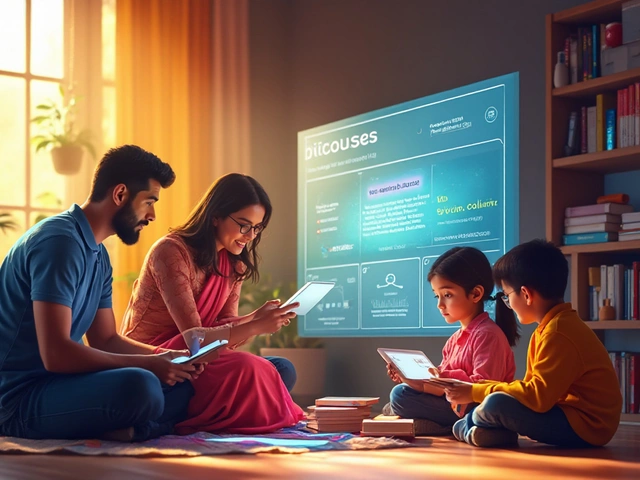
In today’s digital age, distance education has opened new doors for learners worldwide. By leveraging the power of technology, it allows individuals to learn without the constraints of geography or time zones. This article ventures into the heart of distance education, aiming to provide clarity on what it truly means and how it functions.
From utilizing platforms like Zoom to accessing course materials online, distance learning offers a flexible and accessible way to gain knowledge. While it comes with its challenges, the possibilities are nearly endless when approached correctly. Let’s explore how distance education is reshaping the educational landscape, the benefits it brings, and how best to navigate it for personal growth and success.
- The Basics of Distance Education
- Technology in Distance Learning
- Benefits and Challenges
- Tips for Success
- The Future of Distance Education
The Basics of Distance Education
In its simplest form, distance education is learning that takes place away from a traditional classroom setting. It provides access to education for those who might otherwise be unable due to location, commitments, or cost. Unlike conventional schooling, distance education relies heavily on digital platforms and internet access, which allows students to interact with instructors and peers across borders. This model isn't new; its roots trace back to correspondence courses in the 19th century, where lessons were shipped to remote students via post. With the advent of the internet, online learning has evolved significantly, transforming from mail-based activities to interactive digital platforms of today.
Teaching methodologies in distance education can vary widely. Some programs are synchronous, requiring students to log in at specific times for real-time instruction, creating a standard classroom atmosphere minus the physical setting. Others are asynchronous, providing more flexibility, with students accessing content like webinars and discussion boards at their convenience. Well-established systems use a mix of both, ensuring students have some degree of freedom while maintaining consistent engagement.
The role of technology cannot be overstated in distance education. With tools such as video conferencing, online forums, email, and learning management systems, education providers can deliver content effectively. These platforms not only help convey study materials but also facilitate interaction, assessments, and feedback. As technology advances, so does the potential for more immersive and effective learning experiences. There's a growing trend toward incorporating virtual reality and AI-driven tutors in e-learning, adding a layer of interactivity previously unimaginable.
Distance education offers unique advantages, bridging the gap for students in remote or underserved areas. It effectively democratizes education, making it accessible beyond traditional means. Older generations returning to studies, working professionals seeking specialization, or those pursuing lifelong learning find online education particularly appealing. It caters to diverse learning styles and offers pacing that's just right for each individual. "Education is no longer confined to four walls", explains renowned educator John Dewey, highlighting the universal nature of distance education.
"The destination is not just a degree, but the forging of new ways to understand our world," he reflects.
The element of self-discipline plays a crucial role in the success of distance education. Without the structured environment of a classroom, students must establish their own routines and meet deadlines independently. While this fosters self-reliance and accountability, it can be challenging for those accustomed to direct supervision. This is why many programs offer access to mentors or advisors, guiding students through their educational journey. Support systems like these are vital, ensuring students remain motivated and connected, mitigating feelings of isolation that can sometimes accompany remote studies.
To highlight some statistics on distance education, a recent survey found that approximately 33% of high school graduates pursue some form of online learning.
| Study Mode | Percentage of Students |
|---|---|
| Synchronous | 45% |
| Asynchronous | 30% |
| Blended | 25% |
Technology in Distance Learning
In a world where technology propels us forward at a breakneck pace, distance education thrives on the innovations that connect us beyond traditional classrooms. The digital age has ushered in tools and platforms that make learning more accessible and engaging than ever before. One of the game-changers in this space is video conferencing software, with applications like Zoom and Microsoft Teams offering real-time interaction between students and educators, regardless of where they might be physically located. This technology not only facilitates live lectures and discussions but also allows for the ease of collaborative projects conducted from various corners of the globe.
Beyond live interactions, learning management systems (LMS) such as Moodle, Blackboard, and Canvas serve as the backbone of online learning environments. These platforms house everything from course materials and assignments to forums where rich discussions can flourish. They simplify the management of educational content and ensure students have access to on-demand resources. Integration of AI with these systems further enhances the experience, personalizing learning paths and offering timely feedback.
“Technology can become the ‘wings’ that will allow the education world to fly farther and faster than ever before—if we will allow it.” - Jenny Arledge
The rise of e-learning has also seen the integration of multimedia elements into course content. Interactive videos, simulations, and virtual reality modules provide immersive experiences that make complex concepts more tangible. This incorporation not only caters to various learning styles but also enhances engagement, making learning a multi-sensory experience. It's fascinating how a subject like history can be explored through virtual tours of ancient sites while biology comes alive with 3D models of intricate cellular functions.
Technology's role extends further with the use of cloud services, which provides learners with the ability to store, access, and share materials instantaneously. Tools like Google Drive and Dropbox remove the need for physical storage, encouraging collaboration and seamless communication among peers. Asynchronous learning is bolstered by the use of discussion boards and recorded lectures, allowing students to engage with content at their own pace and on their own schedules. As a result, distance education becomes not only flexible but also inclusive, accommodating the diverse lifestyles and responsibilities of students worldwide.

Benefits and Challenges
The rise of distance education has revolutionized how people around the globe perceive and consume education. One of the notable benefits is the sheer flexibility it provides. Unlike traditional classrooms, students have the freedom to tailor their learning schedules to fit their lives, allowing them to balance education with personal and professional responsibilities. Imagine a single parent managing children’s schedules while pursuing a degree without stepping outside the house. This level of convenience was simply unheard of before the advent of the digital learning era.
Moreover, access to a wider variety of courses and programs is another significant advantage. Students aren't restricted by geographical boundaries anymore. Let's consider someone living in a small town in South Africa who can now enroll in a specialized program offered by a university based in the United States. Thanks to e-learning platforms, information is more available than ever, eliminating prior constraints posed by location. This has democratized education substantially, making formidable educational programs achievable by anyone with internet access.
However, distance education does come with its share of challenges. One major hurdle is the lack of face-to-face interaction, leading to feelings of isolation among students. Without the conventional classroom environment, students miss out on social cues and peer support, which can be pivotal to one's learning journey. Additionally, maintaining self-discipline can be difficult when attending courses online, as the absence of physical oversight might make it easy to lose focus. Time management skills become crucial, as online learners eventually figure out there’s often a fine line between productivity and procrastination.
Technology, while an enabler, also serves as a barrier for some. Not everyone has the privilege of uninterrupted, high-speed internet access or advanced computing devices. A survey by the Pew Research Center highlighted that approximately 21% of U.S. adults reported difficulties in connecting reliably to essential remote learning tools. These hurdles can disproportionately affect students from lower socio-economic backgrounds, widening the educational gap further. Institutions must address these inequities to ensure distance learning is genuinely accessible to all.
"Education is the most powerful weapon which you can use to change the world." - Nelson Mandela
To navigate these benefits and challenges effectively, students and educational institutions alike must adapt and innovate. A strategic blend of online and in-person interactions, termed as blended learning, is one way educators are bridging the gap. Schools are also exploring AI-based tutoring tools to provide personalized study paths that mitigate isolation and enhance learning outcomes. By constantly evolving, distance education continues to transform the learning landscape, making it more inclusive and versatile for the future of all learners. For those willing to engage and adapt, the field offers a promising arena to broaden one's horizons in countless ways.
Tips for Success
Navigating through the realm of distance education can be both exciting and daunting. With the flexibility comes the responsibility of self-discipline and effective time management. The very first tip for achieving success in this format of learning is to create a consistent routine. Structure is pivotal; establishing a regular schedule mimicking traditional learning environments enhances focus and productivity. Research suggests that students who maintain strict daily schedules tend to perform better academically. While the virtual classroom offers flexibility, it’s imperative to set designated hours for studying and assignments.
Another crucial tip is to cultivate a productive learning space. This might seem trivial, but having a specific area dedicated to learning can make a substantial difference in concentration levels. Ensure this space is far removed from distractions such as television or social media alerts. Equipping your workplace with necessary tools and a stable internet connection further contributes to a conducive learning environment. Remember, it's about quality, not quantity, and creating a habitat that supports your learning goals is half the battle won.
Engagement, even in a virtual setting, plays a significant role in success. Actively participating in online learning forums, webinars, and discussions helps not only in knowledge retention but also in building a community. According to educational psychologist Dr. John Hattie, “The greatest effects on student learning occur when they become their own teachers.” Embrace the opportunities for interaction that distance education provides. The more you engage, the deeper your understanding goes, and the more connected you feel with the material.
"Consistency and self-motivation are the bricks that build the path of remote success." - Educational Expert
Moreover, mastering digital tools is non-negotiable in e-learning. From learning management systems to collaborative tools, technology is the backbone of distance education. Dedicate some time to familiarize yourself with these platforms and make use of the resources they offer. Many institutions provide tutorials and support sessions—take advantage of them. Being proficient with technology not only smoothens your learning process but also prepares you for future job markets, where digital literacy is a must.
Finally, don’t underestimate the power of self-care. Balancing screen time with physical activity, ensuring adequate rest, and maintaining social connections are vital aspects of distance education. It’s essential to include brain breaks in your schedule, allowing your mind to recharge. The mental and emotional well-being of a learner is as critical as academic achievement. By investing time in physical and mental health activities, you naturally enhance your ability to focus and process information. As we continue to adapt to the ever-evolving landscape of remote studies, remember these tips to make the most of your remote studies journey.

The Future of Distance Education
The landscape of distance education is continuously evolving, morphing into a more inclusive and dynamic mode of learning that transcends traditional boundaries. As technology advances, the methods and capabilities of e-learning are expanding at an unprecedented pace. One can expect a greater emphasis on personalized learning experiences powered by artificial intelligence, which will cater to individual learning paces and preferences. AI algorithms can analyze student data and modify the curriculum in real time to emphasize areas where a learner might be struggling or to skip subjects they have already mastered. This approach not only makes learning more efficient but also keeps learners engaged by tailoring the experience to their personal needs.
More institutions are adopting virtual and augmented reality (VR and AR) to create immersive educational experiences. Imagine studying the solar system by virtually walking among the planets or dissecting a frog without the smell and mess. These technologies provide experiential learning opportunities that are not possible in the physical world, particularly advantageous for fields like medicine, architecture, and archaeology. Moreover, blockchain technology may revolutionize how academic credentials are stored and verified, making them both secure and easily transferable across borders, aiding in global education reach.
"Distance learning is not a single method but a range of methods for improving educational access and quality globally," – The World Bank.
As we move forward, governmental policies are increasingly supporting online learning initiatives. There is a strong push to bridge the digital divide, ensuring that every student, regardless of geographic or economic status, has access to quality education. Projects aimed at providing low-cost internet to remote areas illustrate how important e-learning has become for both development and social equity. With global partnerships, governments and NGOs collaborate to make distance learning accessible, leading to a future where education truly knows no boundaries.
In the realm of higher education and professional training, there is a surging trend towards micro-credentials and bite-sized learning modules. These enable learners to upskill and reskill rapidly in response to changing job markets. Platforms are increasingly issuing digital badges and certificates for these micro-courses, which are becoming recognized by employers worldwide as valid demonstrations of capability. The benefit here is flexibility: learners can adapt their education journey to align with career shifts or personal interests at any time, enhancing their employability across various sectors.
The impact of distance education on the environment is also a critical factor in its future. With traditional campuses requiring vast amounts of energy and resources to maintain facilities and transportation, distance learning significantly reduces the carbon footprint. Sustainable learning is being taken seriously as institutions strive to align with global sustainability goals. This, in turn, influences enrollment choices, with environmentally-conscious students increasingly opting for degrees delivered online to minimize personal environmental impact.
In conclusion, the future of distance education is not just about adopting new technologies or teaching methods but also about re-imagining the educational experience at its core to meet the diverse needs of tomorrow's learners. It promises a future where learning is continuous, borderless, and, most importantly, part of the ecosystem of lifelong learning, preparing humanity for the challenges of an ever-evolving world.





